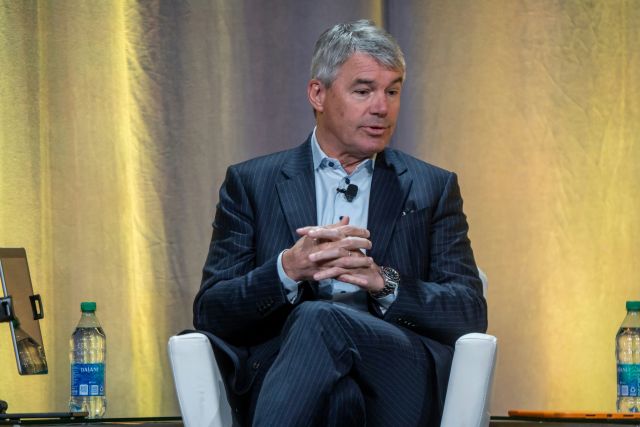
The consensus view within the industry is that the LNG permitting pause will end, in some form or another, after the national election in November, said panelist Mike Bock, partner and CFO of Petrie Partners. (Source: Hart Energy)
The White House’s permitting pause on new LNG projects will cut the growth rate for exports, but the U.S. can still expect a massive capacity expansion for the market over the next two years.
“If you’re assuming it’s a one-year pause, by the time you’re here again next year you will probably not be discussing the pause,” said Amol Wayangankar, principal and founder of Enkon Energy Advisors. Wayangankar was a panelist at the DUG GAS+ Conference and Expo on March 27 in Shreveport, Louisiana, that discussed the future of LNG exports.
If the pause lasts a year, the net result is a 12-month delay for projects that would add about 3 Bcf/d to 4 Bcf/d of LNG to the export market, and the U.S. still gets to an export capacity of about 25 Bcf/d by 2026 or 2027, Wayangankar said.
The consensus view within the industry is that the LNG permitting pause will end, in some form or another, after the national election in November, said panelist Mike Bock, partner and CFO of Petrie Partners.
“It sounds like a lot of construction is continuing,” Bock said.
RELATED
White House Open to Ending LNG Export Pause in Push for Ukraine Aid, Sources Say
Bock said a big reason for optimism is that firms interested in investing in LNG projects do not have a lot of other places to go, even though global demand is expected to continue to grow.
“There’s not a lot of (non-U.S.) options if you’re an investor in this business, because we’re the only place that’s really building capacity,” Bock said.
Outside of the U.S., other gas-producing countries are either business partners to be avoided, such as Russia, or in unstable regions where investment carries additional risk, such as nations in Africa.
Qatar has become the U.S.’ primary competitor for global LNG sales. On March 31, the QatarEnergy announced that it planned to expand its LNG tanker fleet by 19 ships, Reuters reported. The country currently plans to expand its LNG export capacity to 142 MMmt/y by 2030, almost double what the nation can export today.
However, Qatar’s location in the Persian Gulf presents customers with some difficulties. In January the country acknowledged that conflict in the Red Sea was interfering with shipments.
Bock said several major European customers have pivoted their ambitions back to the U.S. market, with an overall expectation that the White House’s LNG pause won’t have a long-lasting effect. Bock also mentioned that Mexico will play a role in exporting U.S. gas in the future.
At least six LNG export projects are under way in Mexico, and the country hopes to ship its first LNG in the coming weeks, from the Altamira Floating LNG unit, owned by New Fortress Energy. Many of the Mexican plants will be largely dependent on natural gas shipped from the U.S.
Most analysts therefore believe it’s a safe bet that the demand for U.S. natural gas will go through a strong growth period starting in 2024 or 2025.
The current infrastructure in some gas basins, particularly the Haynesville and Permian, may not be ready for the surge, said Zack Van Everen, Director of Research at TPH& Co.
They Haynesville is expected to play a key role in the expanding LNG market, because of its proximity to LNG terminals on the Gulf Coast.
“We see a significant (gas) ramp in 2026, and it outpaces the gathering capacity in the Haynesville, which will limit — if they don't start sooner than later — potentially some of that growth,” Van Everen said.
Gas producers and midstream companies face a dilemma right now in terms of building infrastructure. A streak of low natural gas prices makes it difficult to invest in further infrastructure for production, even though producers are aware an increase in demand is coming.
“There is probably going to be a constraint [in the Haynesville] at some point,” Van Everen said. “Talking to some of the private producers and some larger producers, they don't know their plans yet. They don't know what prices are going to do.”
Recommended Reading
Defeating the ‘Four Horsemen’ of Flow Assurance
2024-04-18 - Service companies combine processes and techniques to mitigate the impact of paraffin, asphaltenes, hydrates and scale on production—and keep the cash flowing.
Tech Trends: AI Increasing Data Center Demand for Energy
2024-04-16 - In this month’s Tech Trends, new technologies equipped with artificial intelligence take the forefront, as they assist with safety and seismic fault detection. Also, independent contractor Stena Drilling begins upgrades for their Evolution drillship.
AVEVA: Immersive Tech, Augmented Reality and What’s New in the Cloud
2024-04-15 - Rob McGreevy, AVEVA’s chief product officer, talks about technology advancements that give employees on the job training without any of the risks.
Lift-off: How AI is Boosting Field and Employee Productivity
2024-04-12 - From data extraction to well optimization, the oil and gas industry embraces AI.
AI Poised to Break Out of its Oilfield Niche
2024-04-11 - At the AI in Oil & Gas Conference in Houston, experts talked up the benefits artificial intelligence can provide to the downstream, midstream and upstream sectors, while assuring the audience humans will still run the show.





